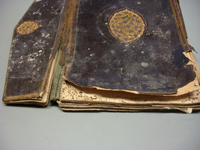Conservation of Codex Glaser 123
|
Condition
The codex showed an overall very worn condition. It had suffered water damage leading to cockling and mold growth. The contact with water had also made the boards split into separate paper layers.
The cover leather showed losses and tears as well as damage from former restorations. The binding, the spine and the head bands were damaged and in a desolate condition. The text block showed worm holes and insect excrements as well as numerous tears and losses.
The binding was made in Turkish style, it is covered with two different goat leathers. “Den-Dann” which surrounds the medallion is painted in light ruby-colour and gold. The reliefs are painted in light and dark ruby-colour on a golden background. In the Turkish book binding tradition this type of binding is called “semse-binding divided at the bottom”. The motifs of the reliefs in the covers are of the same colour as the leather. The deep sections are covered in gold. The covers are framed by golden borders. A small motive in the same style can be found on the flap, “mikleb”.
|
last update
12/2/2015




